Natural Dyes Market Research, 2034
The global natural dyes market was valued at $1.5 billion in 2024, and is projected to reach $2.6 billion by 2034, growing at a CAGR of 6% from 2025 to 2034.
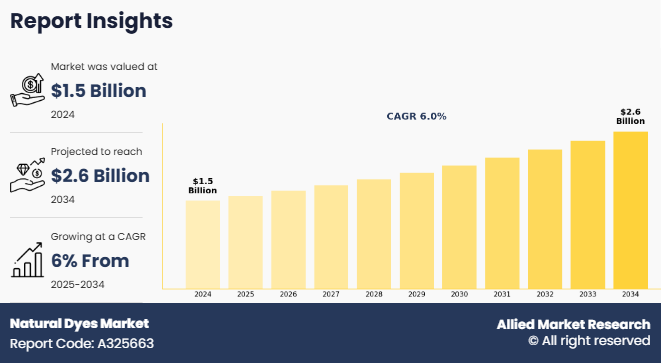
Report Key Highlighters
- The report provides competitive dynamics by evaluating business segments, product portfolios, target market revenue, geographical presence and key strategic developments by prominent manufacturers.
- The natural dyes market is fragmented in nature among prominent companies such as BASF SE, DSM N.V., Abbey Color Incorporated, Stony Creek Colors, Archroma, Evonik, Clariant AG, Huntsman International LLC, Lanxess, and Toray Industries, Inc..
- The study contains qualitative information such as the market dynamics (drivers, restraints, challenges, and opportunities), key regulation analysis, pricing analysis, and Porter’s Five Force Analysis across North America, Europe, Asia-Pacific, LAMEA regions.
- Latest trends in global natural dyes market such as undergoing R&D activities, regulatory guidelines, and government initiatives are analyzed across 16 countries in 4 different regions.
- More than 3,100 natural dyes-related product literatures, industry releases, annual reports, and other such documents of key industry participants along with authentic industry journals and government websites have been reviewed for generating high-value industry insights for global natural dyes market.
Introduction
Natural dyes are colorants derived from natural sources such as plants, minerals, and animals, without any synthetic chemical modifications. These dyes have been used for centuries to color textiles, food, cosmetics, and even artworks. Common plant-based sources include indigo (from the Indigofera plant), turmeric, henna, and madder. Animal-derived dyes, such as cochineal (from insects), and mineral-based pigments like ochre, are also part of this category.
Market Dynamics
One of the primary drivers of the natural dyes market is the increasing awareness of the environmental and health impacts of synthetic dyes. Conventional dyes, widely used in the textile, food, and cosmetics industries, often contain toxic chemicals such as heavy metals, formaldehyde, and azo compounds. These substances not only pose serious health risks to workers and consumers but also contribute to environmental degradation through water pollution and non-biodegradable waste. As societies become more eco-conscious and regulatory bodies tighten environmental norms—especially in Europe and North America—there is a marked shift towards safer, sustainable alternatives. Natural dyes, derived from plants, minerals, and insects, offer a biodegradable, non-toxic substitute, aligning well with global sustainability goals such as the UN's Sustainable Development Goals (SDGs). Brands looking to strengthen their eco-friendly image are increasingly embracing natural dyes to appeal to a growing base of environmentally aware consumers. This trend is particularly strong in premium product segments, where customers are willing to pay more for natural, organic, and ethically produced items.
Furthermore, the adoption of natural dyes is expanding across various industries, with textiles being the largest consumer. The global fashion industry is undergoing a profound transformation as more designers and manufacturers turn to sustainable practices to meet both regulatory standards and consumer demand for ethical fashion. Major fashion houses and fast fashion brands alike are investing in naturally dyed fabrics, driven by the push for "slow fashion" and circular supply chains. Similarly, in the food and beverage industry, natural dyes such as beetroot red, turmeric yellow, and spirulina blue are replacing synthetic food colorants due to their health benefits and regulatory support. With consumers scrutinizing product labels and prioritizing clean ingredients, especially in developed markets, food processors are switching to natural colorants to maintain market competitiveness. The cosmetics and personal care sector is also witnessing an uptick in the use of plant-based pigments in products ranging from lipsticks to shampoos. These trends are fueled by the rising popularity of organic skincare and the broader movement toward "clean beauty," further bolstering the market for natural dyes.
However, one of the most significant restraints in the natural dyes market is the high cost of production and challenges related to scalability. Unlike synthetic dyes, which can be mass-produced using inexpensive petrochemical processes, natural dyes require agricultural inputs, labor-intensive harvesting, and complex extraction techniques. The yield of colorants from natural sources is often low, requiring large quantities of raw material to produce small volumes of dye, which drives up costs significantly. Furthermore, variations in crop yields due to seasonal changes, climate impacts, and agricultural pests can lead to supply instability and inconsistent quality. This lack of standardization makes it difficult for manufacturers to maintain uniform color tones across large production batches —an essential requirement in industries like textiles and cosmetics. Because of these issues, natural dyes are typically more expensive than their synthetic counterparts, limiting their appeal in cost-sensitive markets and making it challenging for manufacturers to adopt them at scale without passing additional costs to consumers.
On the contrary, one of the most promising opportunities for the natural dyes market lies in the rapid expansion of sustainable and ethical consumer markets across the globe. As consumers become more environmentally conscious, there is a notable shift in purchasing behavior towards products that are eco-friendly, cruelty-free, and ethically sourced. Natural dyes align perfectly with this movement, offering a cleaner alternative to synthetic dyes, which are associated with environmental pollution and health hazards. The fashion industry is a key sector where this opportunity is taking shape. Brands that focus on slow fashion, ethical sourcing, and transparency are actively seeking out natural dyes to enhance their environmental credentials. This demand is especially strong in developed markets like Europe, North America, and Japan, where green consumerism is well-established. The opportunity here extends beyond niche or artisanal fashion—larger corporations are now integrating sustainable practices into their mass production lines, creating potential for significant growth in demand for naturally dyed materials.
Segments Overview
The natural dyes market is classified on the basis of source, form, application, chemical behavior, and region. By source, the market is divided into plant, animal, and others. As per form, the market is segregated into powder, liquid, and paste. By application, the market is classified into textile dyeing, food and beverages, cosmetics and personal care, paper, and others. Depending on chemical behavior, the market is segmented into VAT dyes, acid dyes, basic dyes, and others. Region-wise, the market is classified into North America, Europe, Asia-Pacific, and LAMEA.
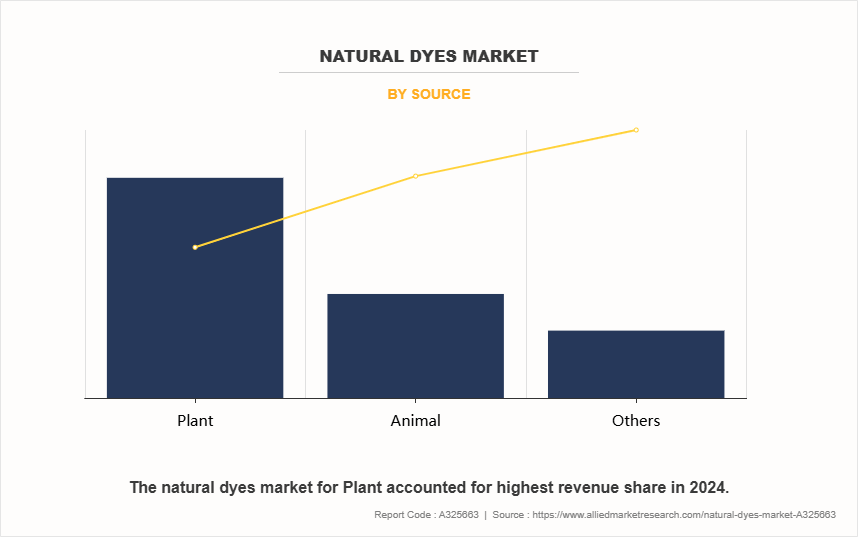
In 2024, the plant segment was the largest revenue generator, and is anticipated to grow at a CAGR of 6.3% during the forecast period. The demand for plant-based natural dyes is increasing due to a growing global emphasis on sustainability, environmental health, and ethical production. Conventional synthetic dyes, widely used in the textile and cosmetic industries, are known for their harmful chemical content, which contributes to water pollution and poses health risks to workers and consumers. In contrast, plant-based dyes offer an eco-friendly alternative that is biodegradable, nontoxic, and generally safer for ecosystems and people. As climate change and pollution concerns intensify, industries and consumers are shifting toward cleaner, greener options, making natural dyes increasingly attractive.
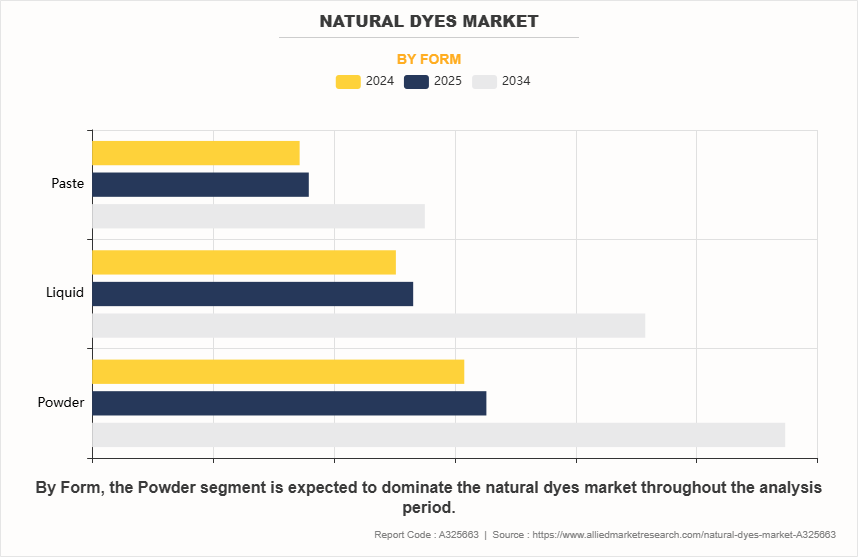
By form, powder accounted for the largest share, in terms of revenue in the global natural dyes market and is anticipated to grow at a CAGR of 6.5% during the forecast period. The demand for powder-based natural dyes is increasing due to their convenience, sustainability, and alignment with the growing consumer preference for eco-friendly products. As environmental awareness rises, industries such as textiles, cosmetics, and food are moving away from synthetic dyes, which are often harmful to both health and the environment. Powder-based natural dyes offer a biodegradable, non-toxic alternative that is easy to handle, store, and transport. Because the dyes are dehydrated, they are more stable and have a longer shelf life compared to liquid extracts, making them ideal for small-scale artisans as well as large-scale manufacturers.
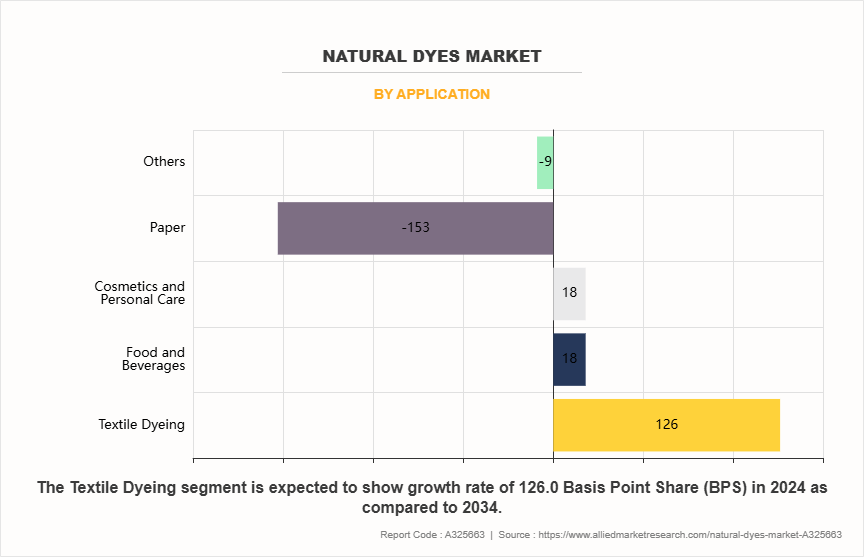
By application, the textile dyeing segment dominated the global market in 2024, and is anticipated to grow at a CAGR of 6.3% during the forecast period. The demand for natural dyes in textile dyeing applications is increasing due to growing consumer awareness about the environmental and health impacts of synthetic dyes. Synthetic dyes, which are widely used in the textile industry, are often made with toxic chemicals that can pollute water sources and harm ecosystems. Natural dyes, derived from plants, insects, and minerals, offer a more eco-friendly alternative. They are biodegradable, non-toxic, and typically have a smaller carbon footprint, aligning with the global trend toward sustainability and eco-conscious production methods. As consumers become more discerning about the environmental impact of their purchases, manufacturers are increasingly turning to natural dyes to meet demand for greener alternatives.
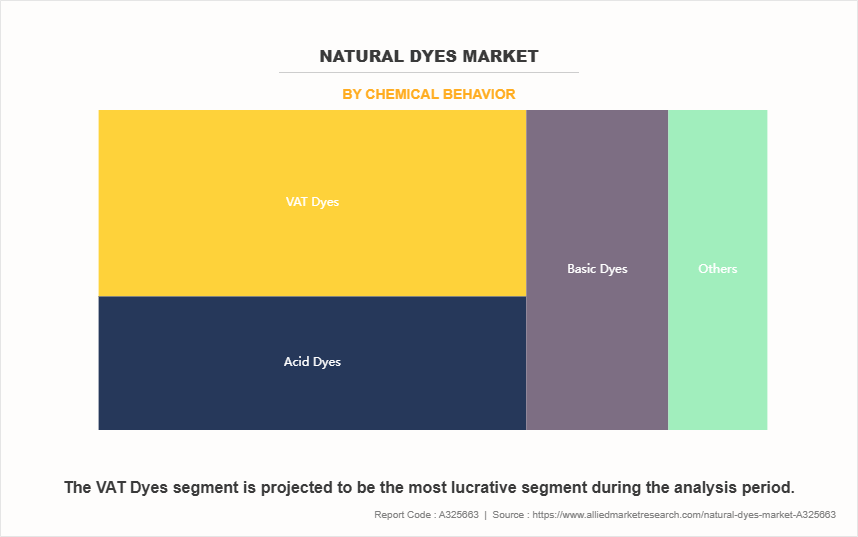
In 2024, the VAT Dyes segment was the largest revenue generator, and is anticipated to grow at a CAGR of 6.3% during the forecast period. The demand for VAT dyes is increasing due to their superior colorfastness and long-lasting results, making them highly popular in industries where durability is essential. VAT dyes, such as indigo, offer vibrant, deep colors that are resistant to fading from light and washing. This is particularly important in denim, where indigo is widely used for its rich blue hues and ability to maintain its intensity even after repeated washes. As consumers increasingly seek products that offer longevity and quality, the need for colorants that can endure over time is growing. VAT dyes, with their ability to withstand exposure, provide a solution for products requiring sustained visual appeal.
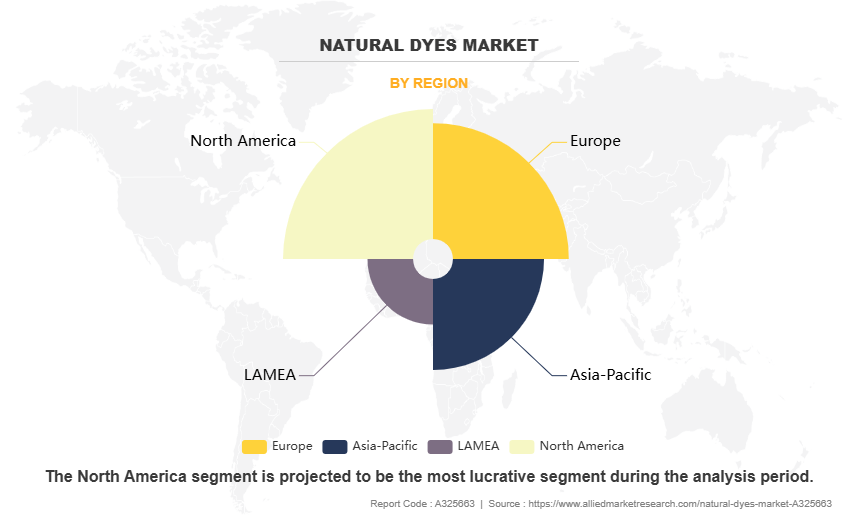
The North America natural dyes market size accounted for 34.0% of natural dyes market share in 2024. The demand for natural dyes is increasing in the United States primarily due to a growing awareness of health, wellness, and environmental sustainability. Consumers are becoming more conscious of the harmful effects of synthetic dyes used in foods, textiles, cosmetics, and pharmaceuticals. As a result, industries are responding by incorporating plant-based, mineral, and insect-derived colorants into their products. The U.S. Food and Drug Administration (FDA) also imposes strict regulations on artificial additives, which has led manufacturers to seek safer, compliant alternatives. Natural dyes meet these standards and appeal to consumers seeking clean-label, non-toxic, and eco-conscious products, especially in food, organic textiles, and personal care.
Competitive Analysis
The global natural dyes market profiles leading players that include BASF SE, DSM N.V., Abbey Color Incorporated, Stony Creek Colors, Archroma, Evonik, Clariant AG, Huntsman International LLC, Lanxess, and Toray Industries, Inc.
Industry Trends:
- The natural dyes market is witnessing significant growth, driven by increasing consumer demand for eco-friendly products. A recent survey report showed that, 78% of consumers prioritize sustainability, and 55% are willing to pay more for eco-friendly brands. This trend is particularly noticeable in textiles, cosmetics, and food, where safe and biodegradable options are increasingly sought after. Furthermore, 84% of customers would only support brands with good environmental practices. In response, manufacturers are adjusting their products to include natural dyes from plants, insects, and minerals, in line with sustainability goals. As a result, these factors are fueling substantial growth of the natural dyes market.
- Government regulations are also shaping the market landscape. Strict environmental policies targeting pollution from synthetic dyes and industrial wastewater are prompting manufacturers to explore eco-friendly alternatives. Bans on hazardous chemicals, coupled with financial incentives for sustainable practices, further accelerate this shift. Industries are adopting natural dyes to comply with regulatory frameworks, enhance their brand reputation, and meet the growing consumer demand for ethical and sustainable products.
- Recent developments by natural dye manufacturers highlight the industry's commitment to innovation and sustainability. In May 2024, AMA Herbal launched Bio Indigo PreR, a biochemically modified pre-reduced natural indigo in liquid form. This product offers benefits such as reducing energy consumption, COâ‚‚ emissions, and providing economic opportunities for farmers. In January 2023, AMA Herbal signed a Memorandum of Understanding with Amity School of Fashion Technology to promote sustainability in fashion design education.
Key Benefits For Stakeholders
- This report provides a quantitative analysis of the market segments, current trends, estimations, and dynamics of the natural dyes market analysis from 2024 to 2034 to identify the prevailing natural dyes market opportunities.
- The market research is offered along with information related to key drivers, restraints, and opportunities.
- Porter's five forces analysis highlights the potency of buyers and suppliers to enable stakeholders make profit-oriented business decisions and strengthen their supplier-buyer network.
- In-depth analysis of the natural dyes market segmentation assists to determine the prevailing market opportunities.
- Major countries in each region are mapped according to their revenue contribution to the global market.
- Market player positioning facilitates benchmarking and provides a clear understanding of the present position of the market players.
- The report includes the analysis of the regional as well as global natural dyes market trends, key players, market segments, application areas, and market growth strategies.
Natural Dyes Market Report Highlights
| Aspects | Details |
| Market Size By 2034 | USD 2.6 billion |
| Growth Rate | CAGR of 6% |
| Forecast period | 2024 - 2034 |
| Report Pages | 463 |
| By Source |
|
| By Form |
|
| By Application |
|
| By Chemical Behavior |
|
| By Region |
|
| Key Market Players | Evonik, Huntsman International LLC, Stony Creek Colors, Toray Industries, Inc., DSM N.V., Abbey Color Incorporated, Clariant AG., BASF SE, LANXESS, Archroma |
Analyst Review
According to the CXOs of leading companies, natural dyes offer a unique value proposition in aligning corporate strategies with sustainability goals. They enhance brand differentiation in an increasingly eco-conscious market, especially among Gen Z and millennial consumers. Integrating natural dyes supports ESG (Environmental, Social, and Governance) frameworks and opens doors to green certifications, investor interest, and long-term brand equity. Despite cost and scalability challenges, CXOs view natural dyes as a high-potential investment area, especially with advancements in biotech and plant-based chemistry. Forward-thinking leaders are prioritizing R&D partnerships, vertical integration with local supply chains, and market education to scale adoption. The market represents a strategic pivot toward circular economy models and premium product positioning.
Growing Environmental and Health Concerns, Rising Demand in Textiles, Food, and Cosmetics Industries, and Technological Innovations and Government Support are the upcoming trends of Natural Dyes Market in the globe
Textile dyeing is the leading application of Natural Dyes Market.
North America is the largest regional market for Natural Dyes.
The natural dyes market was valued at $1.5 billion in 2024 and is estimated to reach $2.6 billion by 2034, exhibiting a CAGR of 6.0% from 2025 to 2034.
BASF SE, DSM N.V., Abbey Color Incorporated, Stony Creek Colors, Archroma, Evonik, Clariant AG, Huntsman International LLC, Lanxess, and Toray Industries, Inc. are the top companies to hold the market share in the natural dyes market.
Loading Table Of Content...
Loading Research Methodology...



